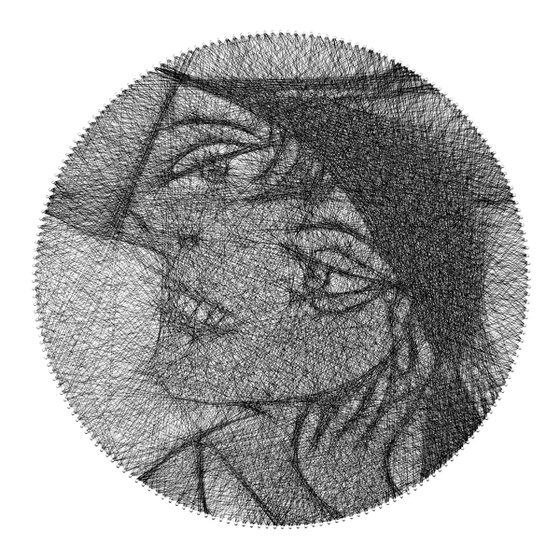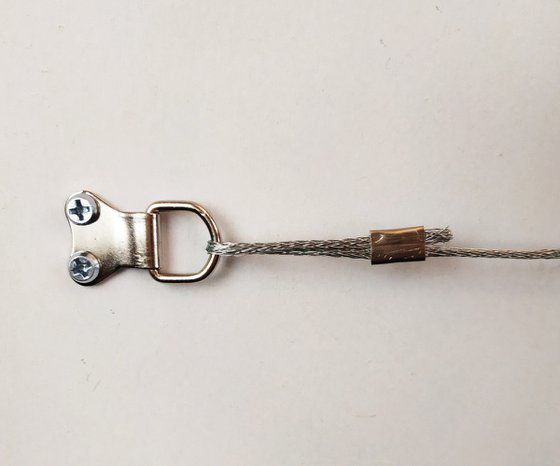- By medium
- By subject
- By budget
- Sales
- Gift cards
- Discover all art
- Artists
- Editors’ picks
- Ideas
Artwork description:
Olga Khokhlova was the first wife and muse of Pablo Picasso, however, their love underwent a metamorphosis. So did the image of Olga, deified in early works and caricatured in the later periods of Picasso's work. Despite this, thanks to the artist's brush, the name of his first wife has remained in centuries. This original string portrait is a reproduction of a fragment of a portrait of Olga by Pablo, reminiscent of the fact that time has a bizarre sense of humor.
The original string art technique that created this stunning piece involves wrapping several kilometers of a continuous mono-thread around an evenly spaced circle of 200 aluminum pins. The thread cross, re-cross, and crisscross a circular area above the flat wooden board. The image within the circle is achieved by the painstaking and complex choice of thousands of connections between the pins. After the first 30 connections that make up the image, the number of possible knitting variants exceeds the number of atoms in the Universe! So it’s simply impossible to reproduce this artwork by guesswork or to untangle it with your mind...
Just think, by what kind of magic does the same string that produces only random noise around the image suddenly condense and accurately repeats the complex shape? That's quite amazing... As if by the creator's plan, the string meticulously draws the figure in the air, and from this unifying beginning, the entire piece is interconnected... even the smallest element is an inseparable part of the whole, which brings up deep symbolic meaning to the artwork.
Materials used:
String, Nails
Tags:
#time #black and #picasso #wall art #abstract art #cubism #muse #humor #surrealistic #string artFeatured by our Editors:
Time's bizarre sense of humor (2020) Sculpture
by Andrey Saharov
9 Artist Reviews
£1,019.16
- Sculpture on Panel / Board / MDF
- From a limited edition of 20
- Size: 76 x 76 x 1cm / 76 x 76cm (actual image size)
- Ready to hang
- Signed and numbered on the back
- Style: Expressive and gestural
- Subject: Abstract and non-figurative
Loading
Artwork description
Olga Khokhlova was the first wife and muse of Pablo Picasso, however, their love underwent a metamorphosis. So did the image of Olga, deified in early works and caricatured in the later periods of Picasso's work. Despite this, thanks to the artist's brush, the name of his first wife has remained in centuries. This original string portrait is a reproduction of a fragment of a portrait of Olga by Pablo, reminiscent of the fact that time has a bizarre sense of humor.
The original string art technique that created this stunning piece involves wrapping several kilometers of a continuous mono-thread around an evenly spaced circle of 200 aluminum pins. The thread cross, re-cross, and crisscross a circular area above the flat wooden board. The image within the circle is achieved by the painstaking and complex choice of thousands of connections between the pins. After the first 30 connections that make up the image, the number of possible knitting variants exceeds the number of atoms in the Universe! So it’s simply impossible to reproduce this artwork by guesswork or to untangle it with your mind...
Just think, by what kind of magic does the same string that produces only random noise around the image suddenly condense and accurately repeats the complex shape? That's quite amazing... As if by the creator's plan, the string meticulously draws the figure in the air, and from this unifying beginning, the entire piece is interconnected... even the smallest element is an inseparable part of the whole, which brings up deep symbolic meaning to the artwork.
Materials used:
String, Nails
Tags:
#time #black and #picasso #wall art #abstract art #cubism #muse #humor #surrealistic #string artFeatured by our Editors:
14 day money back guaranteeLearn more



